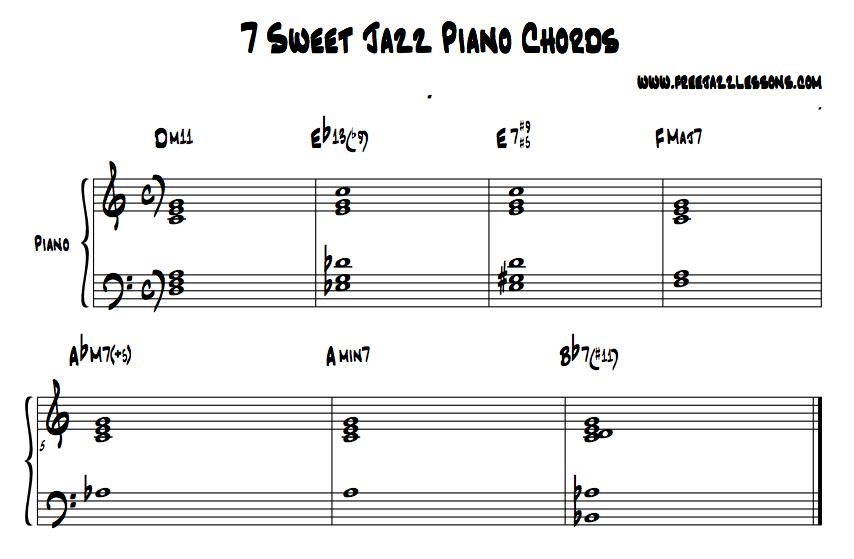Learn 7 Sweet Piano Chords
 Hey everybody! To celebrate the launch of my jazz instructional DVD “The Jazz Masters Method” (on Monday, October 8th 2012).
Hey everybody! To celebrate the launch of my jazz instructional DVD “The Jazz Masters Method” (on Monday, October 8th 2012).
I wanted to share a quick free piano lesson with you guys before the release. 🙂
(Update: The DVD has been released!! You can get access to the 9 jazz masters right here The Jazz Masters Method DVD )
The DVD is full exploration of the chords, licks, and playing concepts of 9 legendary jazz piano players:
Barry Harris, Bud Powell, Bill Evans, Oscar Peterson, Ray Charles, Red Garland, Diana Krall, Chick Corea, and Herbie Hancock.
I’m excited to showcase the playing of these true jazz piano legends starting on Monday October 8th 2012! (Check back on the site this Monday for special limited bonuses).
……………
Ok, on to our free lesson….
So, in today’s piano lesson we’re going to take a really deep look at 7 very sweet jazz piano chords. (video piano lesson, notation, and tips below.)
The very cool part of this lesson is that every jazz piano chord we learn will feature C triad somewhere within it.
Don’t underestimate this lesson though. There are some powerful chords in here!
I wanted to show how you could take a simple concept that almost everybody is already familiar with and turn it into several very beautiful and rich sounding chords.
I suggest you watch the video first to get started and then scroll down for the notation and additional tips.
The 7 Sweet Piano Chords Notation
(click to expand)
9 Tips To Help You Learn These Piano Chords
1. Every chord features a plain old C major chord as part of it. By adding notes below this C major chord we create a much larger jazz chord.
2. Many of these chords in this lesson are considered upper structure triads (or UST for short).
- The basic concept behind an upper structure triad is simple. Take a major or minor triad and use it as an upper extensions of a jazz chord.
- So, for example you could start with a Dminor chord (D F A). This would be the 1, b3, and 5th of this chord.
- If we add a C triad on top (C E G) these notes would be the b7, 9, and 11th of our D minor chord. We would call this big chord a Dmin7(11,9) or a D min11 chord.
- If you’re confused you can check out the notation for this chord right above. I also explain it step by step on the video above. 🙂
3. If you want to see some upper structure triads in action check out the Here’s That Rainy Day piano lesson .
I use a bunch of upper structure triads in that jazz piano arrangement. If you’re looking for the
best chords for piano jazz arrangements, then you’ll love the voicings I demonstrate in that one.
4. Whenever you’re learning new jazz piano chords, I suggest you take each voicing through all 12 keys. It really helps you nail the theory, the sound, and the tactile memory of each chord.
5. In order to best learn these chords I also suggest you apply them to your favorite jazz standard or even a really common jazz chord progression like a II-V-I.
You could even apply many them to many of the chords on Autumn Leaves.
6. Notice how even though we start with a major triad the larger chords we built are a mix of major, minor and dominant chords.
So, a simple major chords can expand into much richer possibilities.
7. If you enjoy the sound of these chords then you should also check out more of the jazz chord lessons on this site.
8. Cool jazz chords don’t have to be complicated. You can get some really simple jazz piano chords from just stacking triads. There are obviously lots of takeaways from the video. But, if you focus on the fact that there is a triad in all the chords, you’re making a big revelation.
9. Want a list of other piano players who use this type of piano harmony? Check out this list of important jazz piano players.
Question For You
Before we end this lesson I’d like to ask you as a guest or member of our jazz community here. What’s your favorite jazz piano chord from this lesson? How do you plan on becoming a better jazz piano player? How will you use these chords in your music? What keeps you motivated to become the best jazz piano player you can be?
Please leave a comment below and let us know. I look forward to responses! Happy practicing. 🙂
****************
If you enjoyed this chord lesson please be sure to subscribe to the freejazzlessons email list. (Either right below this article or on the top right)
- You’ll be joining one of the fastest growing jazz and music education communities online today!
- You’ll also receive the latest and greatest lessons as soon as their published. Right in your inbox!

